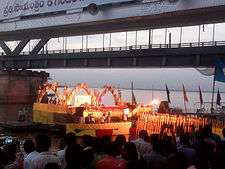Godavari Maha Pushkaram
Godavari Maha Pushkaram (Great Worship of the Godavari River) was a Hindu festival held from 14 July to 25 July 2015. This festival occurs once every 144 years, corresponding to the 12th recurrence of the 12-year Godavari Pushkaram cycle.[2]
| Godavari Maha Pushkaram | |
|---|---|
 | |
Godavari River at sunset at Rajahmundry | |
| Status | Active |
| Genre | Hindu festivals |
| Frequency |
|
| Venue | |
| Location(s) | Godavari River |
| Country | India |
| Previous event | 14 August 2015 |
| Next event | 2027 |
| Participants | 110 million (64mn in Telangana state and 46mn in Andhra Pradesh) (official)[1] |
| Area | Maharashtra, Telangana, Chhattisgarh, Andhra Pradesh |
| Budget | INR 2300 crores (in 2015) |
| Activity | Holy river dip and worship at the temples on the banks of the river |
| Website | godavarimahapushkaram.org |

The festival starts from the Ashadha (June/July) month on the Chaturdashi day (thithi) (14th day), when planet Jupiter enters the zodiac sign of Leo.[2][3] The festival is "theoretically" observed throughout the twelve months that the planet remains in that sign, but the first 12 days are considered most sacred.[4][2][5][3] The first 12 days of the Godavari Pushkaram are known as "Aadhi Pushkaram" and the last 12 days are titled "Anthya Pushkaralu".[6] The next Maha Pushkaram will be celebrated in 2159.[2]
At least 27 pilgrims, 13 of them women, died and 20 others injured in a stampede at a major bathing spot on the banks of the Godavari river where a huge crowd of devotees had gathered on the opening day of 'Pushkaram' festival.[7]
Etymology
"Maha" means "great" and Pushkaram refers to the worship of the river in which the god Pushkar appears every 12 years.[8] Pushakaram is spelled Pushkaralu in Telugu, Pushkaram in Tamil, Pushkara in Kannada, and Pushkar in Hindi.
Background
Pushkaram is an Indian festival dedicated to worshiping of 12 sacred rivers. The celebration happens annually, once in 12 years along each river. Each river is associated with a zodiac sign, and the river for each year's festival is based on which sign Bruhaspathi (Jupiter) is in at the time.[9] It is believed that bathing in the sacred river during Pushkaram cleanses the devotees of their sins.[8]
Godavari is one of the 12 sacred rivers, and the Godavari Pushkaram takes place once every 12 years, when the Jupiter is in the Leo sign. The Maha Pushkaram ("Great Pushkaram") takes place once every 144 years.
Festival dates
The 2015 Godavari Pushkaram is believed to be a Maha Pushkaram, which happens once in 144 years. During the year 2015, Jupiter enters Leo on 14 July 2015 (Tuesday) at 6.26 AM, when the Maha Pushkaram begins, and ends after 12 days on 25 July 2015 (Saturday).[8]
Multiple almanac writers and other skeptics have disputed that the 2015 Godavari Pushkaram is a "Maha Pushkaram". According to Hanmanthavajjula Subrahmanya Sarma, the president of State Drukghanitha Almanac Writers’ Association, the "theory of 144 years is a myth", and nobody knows "who calculated it and how they calculated it".[10]
Details of locations
The places on the banks of the Godavari River where pilgrims visit famous temples are in the five districts of Telangana and Andhra Pradesh. The notable places are Manthani, Basar, Dharmapuri, Koti Lingala, Kaleshwaram, Bhadrachalam [11] in Telangana and Rajahmundry,[12] Kovvur, Narasapuram, Antervedi in Andhra Pradesh.
Facilities
The Maha Pushkaram festival in 2015 attracted 48.1 million people in Andhra Pradesh and 57 million people in the Telangana state link from all parts of India.[13] On this occasion, it is essential to take a holy dip in the Godavari River to get the supposed benefits of better physical and mental abilities.[14] The Governments of Andhra Pradesh and Telangana have made all arrangements for this event in their respective states by constructing ghats for bathing and improving road communications, basic amenities of water supply and sanitation, and security. In Andhra Pradesh. the budget allocated for improvement of infrastructure facilities is INR 1,295 crores.[4]
Symbolism

An emblem titled "Godavari Maha Pushkaram 2015" and "Godavari Pushkaramalu" has been adopted by the state governments for this festival, and a special organization under the same name has also been instituted to address all issues related to the smooth functioning of the festive event. The emblem or logo with a simple design has lines to denote the rapid flow conditions of the Godavari River, a "jyoti" a glowing light, and the representation of offering oblation, called "Arghyam", to Surya, the Sun god.[15]
Another symbolic event [16] proposed during the festival is to hold "Sobha Yatra", a procession carrying the sacred waters of the Godavari River to be mixed with water bodies in all the villages in the 13 districts which lie within the ambit of the Godavari River.[16]
A religious symbolic performance called the "Godavari Harathi", a ritual of worship with a number of lamps, similar to the Ganga Aarti that is conducted on the banks of the Ganges in Varanasi, is also proposed to be held at Rajahmundry where the river flows out to the sea.[2]
See also
- List of largest gatherings in history
- Pushkaram
References
- "Over 11 crore took dip in Godavari during 12 days". Business Standard India. IANS.in. 26 July 2015. Retrieved 26 July 2015.
- "Godavari Maha Pushkaram 2015". Official website of Godavari Mahapushkaram Organization. Archived from the original on 2 July 2015. Retrieved 3 June 2015.
- Dalal 2014, p. 921.
- "CM Chandrababu reviews Godavari 'Maha Pushkaram'". Eenadu India.com. Retrieved 11 June 2015.
- Ranee Kumar (26 July 2003). "Holy Dip". The Hindu.
- Pillai 1996, p. 14.
- http://articles.economictimes.indiatimes.com/2015-07-14/news/64405897_1_holy-dip-godavari-river-pushkaram
- "Godavari Pushkaralu 2015 schedule Pushkar Ghat Details". News19. 9 June 2015. Retrieved 4 July 2015.
- Dalal 2014, pp. 921–.
- "Confusion over '144 Year' old Godavari Kumba Mela grips Pushkaram". Deccan Chronicle. 18 July 2014.
- "Bhadrachalam readies for Pushkaralu". The Hindu. 14 July 2015. Retrieved 14 July 2015.
- "Volunteers flocking to Rajahmundry". The Hindu. 14 July 2015. Retrieved 14 July 2015.
- Bureau, Andhra Pradesh (25 July 2015). "4.81 cr. pilgrims took holy dip in Godavari Pushkaram: AP Minister". The Hindu. Retrieved 25 July 2015.
- "Godavari Pushkaralu". The Hindu. 28 June 2015. Retrieved 28 June 2015.
- PTI (20 May 2015). "Andhra Pradesh govt chalks out grand plans for Godavari 'Maha Pushkaram". The Indian Express. Retrieved 26 June 2018.
- https://web.archive.org/web/20150723044419/http://bridgecounty.com/wordpress/2015/07/21/godavari-mahpushkaram-recap-of-last-7-days/. Archived from the original on 23 July 2015. Retrieved 22 July 2015. Missing or empty
|title=(help)
Bibliography
- Dalal, Roshen (18 April 2014). Hinduism: An Alphabetical Guide. Penguin Books Limited. ISBN 978-81-8475-277-9.CS1 maint: ref=harv (link)
- Pillai, L.D.S. (1 December 1996). Panchang and Horoscope. Asian Educational Services. ISBN 978-81-206-0258-8.CS1 maint: ref=harv (link)
External links
| Wikimedia Commons has media related to Godavari Pushkaram. |
| Wikivoyage has a travel guide for Rajahmundry. |

